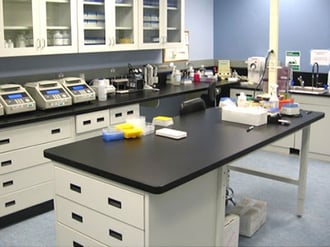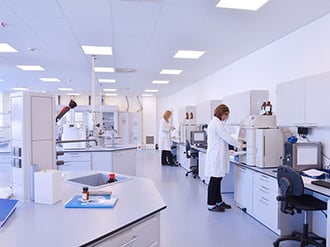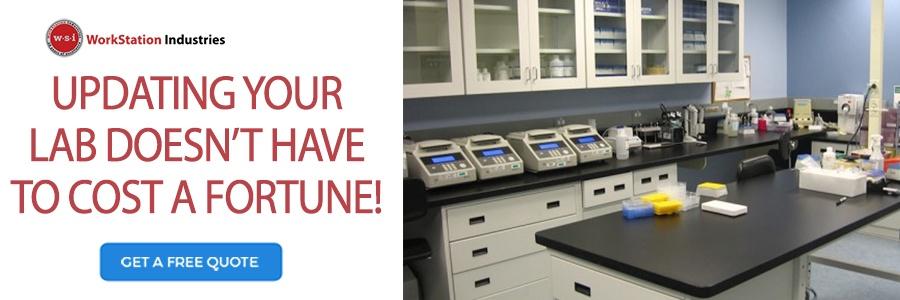You have been tasked with designing your company’s new lab, but you haven’t kept up on new trends in laboratory furniture. You know what your basic needs will be, but the one thing you are uncertain about is what lab countertops to use for your science tables.
In our last article, we looked at the factors that need to be considered when selecting a lab work surface. Today we will look at the available options and their characteristics to understand which material may be most suitable, based upon your specific laboratory needs.
Businesses are using labs for many applications these days...education, inspection, research and development, technology, and testing to name a few. One of the biggest challenges for businesses today is that they are constantly changing. So, you not only have to choose lab countertops for today’s usage, but also future possible uses.
Let’s look at the top five that we recommend you consider:
Phenolic Resin
Phenolic resin countertops are manufactured by layering natural kraft paper that has been saturated with phenolic resin and processed under high heat. The result is one solid, lightweight countertop that is durable and long-lasting.
 Advantages of Phenolic Countertops
Advantages of Phenolic Countertops
- Moderate Duty
- High Bacterial Resistance
- High Chemical Resistance
- Moderate to High Corrosive Resistance
- High Fungal Resistance
- High Moisture Resistance
- High Scratch Resistance
- Continuous heat exposure up to 350 °F
- Holds up to impact and stress fractures
- Mid Price
Disadvantages of Phenolic Countertops
- Not Flame Retardant
Pricing
If you are looking for a highly chemically resistant countertop at a reasonable price for your science table, this is the material you want to use. It is in the mid range as far as price with only High Pressure Laminate being cheaper. The only downside to this material is that it isn't recommended for use with open flames.
Best Applications
Biological, Chemical, Clinical, and Analytical Labs. Labs performing experiments and tests where results depend on non-contamination and require laboratory work surfaces that are exceptionally chemical resistant, impervious and hygienic.
Epoxy Resin
Epoxy resin countertops are made from a mixture of materials and then cured as a solid product. They are durable, non-porous and hold up very well under harsh and extreme conditions. They are typically the choice for stations that have sinks and heavy moisture.
Advantages of Epoxy Countertops
- Heavy Duty
- High Bacterial Resistance
- High Fungal Resistant
- High Corrosive Resistance
- High Chemical Resistance
- High Water and Moisture Resistance
- High Scratch Resistance
- Continuous heat exposure above 350 °F
- Flame retardant
- Holds up to impact and stress fractures
Disadvantages of Epoxy Countertops
- High Price
Pricing
This is the most durable of all the other materials on our list and made for the most extreme lab conditions. It is also the most expensive, because of the limited number of manufacturers. The decision to pay the extra price for this material will depend on whether you need the additional heat resistance on your science table and the ability to use open flames on your lab countertops, because it handles that well.Biological Science, Education, Hospital, Industrial Testing, Medical, Microbiology, and Research and Development Labs. Labs performing experiments and tests that use harsh chemicals, open flames and instruments that create extreme heat and require worksurfaces that are durable, resistant to the most aggressive chemicals, and easy to clean and maintain.
Stainless Steel
Stainless steel countertops are made of low carbon steel that is made up of chromium and nickel. Chromium makes it resistant to rust and corrosion, while nickel makes it stain and heat resistant.
Stainless steel has a non-porous surface, which means that no liquids or substances can penetrate into the material at all. Bacteria, mold and other common household germs don’t stand a chance with stainless.
Advantages of Stainless Countertops
- Moderate to Heavy Duty
- High Bacterial Resistance
- Moderate Chemical Resistance
- Moderate Corrosive Resistance
- High Fungal Resistance
- High Water and Moisture Resistance
- Continuous heat exposure above 1500 °F, but may discolor at prolonged high temperatures
Disadvantages of Stainless Countertops
- Low Scratch Resistance
- Dents easily on impact
- High Price
Pricing
This material gives your lab a very modern look and has moderate to high resistance to various conditions. The best benefit is its ability to handle very high heat. It is on the higher end as far as price, with Epoxy Resin being the only material that is more expensive.
Best Applications
Biological science, chemical, clean room, food testing, hospital, medical, and pharmaceutical labs. Labs performing experiments and tests where results depend on non-contamination, require worksurfaces that can handle high temperatures and are easily cleanable.
Chemical Resistant Laminate
Chemical laminate is made by applying a melamine resin over decorative surface paper, which is then bonded to a core of kraft papers impregnated with phenolic resin. The result is a decorative worksurface that is functional, durable and highly resistant to chemicals. It is not recommended for exposure to extremes in humidity or heat over 275°F for suspended periods of time.
Advantages of Chemical Laminate Countertops
 High Chemical Resistance
High Chemical Resistance- Heat exposure up to 275°F
- Designer Looks
- Mid Price
Disadvantages of Chemical Laminate Countertops
- Light Duty
- Low Bacterial Resistance
- Low Corrosive Resistance
- Low Fungal Resistance
- Low Water and Moisture Resistance
- Low Scratch Resistance
- Can chip at seams and get surface cuts
Pricing
If you are looking for a reasonably priced worksurface that is chemically resistant and has a more designer look for your lab tables, this is a good option. It is in the mid range for price and less expensive than Epoxy Resin and Stainless Steel. The downside is it should only be used for dry applications and can damage more easily.
Best Applications
Beauty product, dental, pathology labs, photographic darkroom, product testing, and urology labs. Labs performing experiments and tests where results depend on non-contamination and require worksurfaces that are chemical resistant, decorative and hygienic.
High Pressure Laminate
High pressure laminate is made by applying a melamine resin over decorative surface paper, which is then bonded to a core of kraft papers impregnated with phenolic resin. The result is a decorative worksurface for your science lab table that is functional and durable. It is not recommended for exposure to extremes in humidity or heat over 275°F for suspended periods of time.
Advantages of Laminate Countertops
- Heat exposure up to 275°F
- Designer Looks
- Low Price
Disadvantages of Laminate Countertops
- Light Duty
- Low Bacterial Resistance
- Low Chemical Resistance
- Low Corrosive Resistance
- Low Fungal Resistance
- Low Water and Moisture Resistance
- Low Scratch Resistance
Pricing
This is the most economical of all of the materials on our list, but is a general purpose countertop to be used in chemical-free, dry applications only. The best benefit of this material is that there are a lot of designer looks to choose from.
Best Applications
Product testing and technology labs. Labs performing general functions that require worksurfaces that are functional, durable and decorative.
Lab countertops should be a long-term investment. It is important to consider the type of work you are doing in your lab now and anticipate what you might do in the future. Budget is always important, but your choice must be able to stand the test of time and the rigors of your work.
Other Materials For Your Science Tables
The five choices we outlined above all offer advantages and disadvantages of some of the top materials available for lab and science tables. However, depending on your workers’ or students’ needs and lab’s applications, you may need an alternative choice.
The following are some additional materials commonly used in laboratory spaces.
-
ESD Laminate work surfaces are ideal for applications where parts and materials are sensitive to static and need protection.
-
Solid surface countertops are durable and easy to maintain. They also feature invisible seams, making them aesthetically pleasing. How to clean solid surface countertops is a common concern, but rest assured that this material is one of the easiest to maintain and keep in top working order.
-
Butcher Block countertops are traditionally used in woodworking and basic assembly applications. While this type of countertop is sturdy, it’s also porous and can dent easily. This type of material likely isn’t an appropriate choice for a laboratory setting unless used in non-work areas or in science labs where abrasive chemicals are not handled.
-
Stone countertops are durable and heat-resistant. They can be made from materials such as granite, quartz or marble.
It’s important when weighing your options to consider your lab’s specific needs … now and in the future. Often, a laboratory’s applications will evolve and you will want to ensure the investment you make now can withstand any future applications you bring into your lab. Companies that sacrifice quality for price could be headed for problems and end up spending more money than they planned down the road.
A Checklist For Choosing Your Lab Countertop
The science table top material you choose is an important investment for your workspace. With several options to consider, here is a checklist of considerations common in a lab space to keep in mind:
-
Chemical resistance: Choose a material that can withstand the chemicals and substances you use in the lab currently or could be using in the future.
-
Heat resistance: Consider the maximum temperature you will need to withstand and choose a material that can handle it. Remember to consider continuous heat exposure as well.
-
Durability: Do you have heavy or sharp equipment? Choose a material that is scratch-, stain- and impact-resistant to ensure longevity.
-
Maintenance: Hygiene is important in any laboratory setting, so choose a material that is easy to clean and maintain.
-
Cost: Consider your budget and choose a material that fits within your financial constraints. Remember to consider long-term costs as well.
-
Appearance: Choose a material that complements the design and aesthetic of your lab.
-
Availability: Lead time can impact all areas of your operation. If you need material quickly, this could influence your final decision.
High-quality industrial workbench manufacturers can help ensure your lab design is functional, safe and meets all the necessary industry standards and regulations. A lab furniture professional should work through each of these considerations with you to help determine the best countertop material for your needs.


